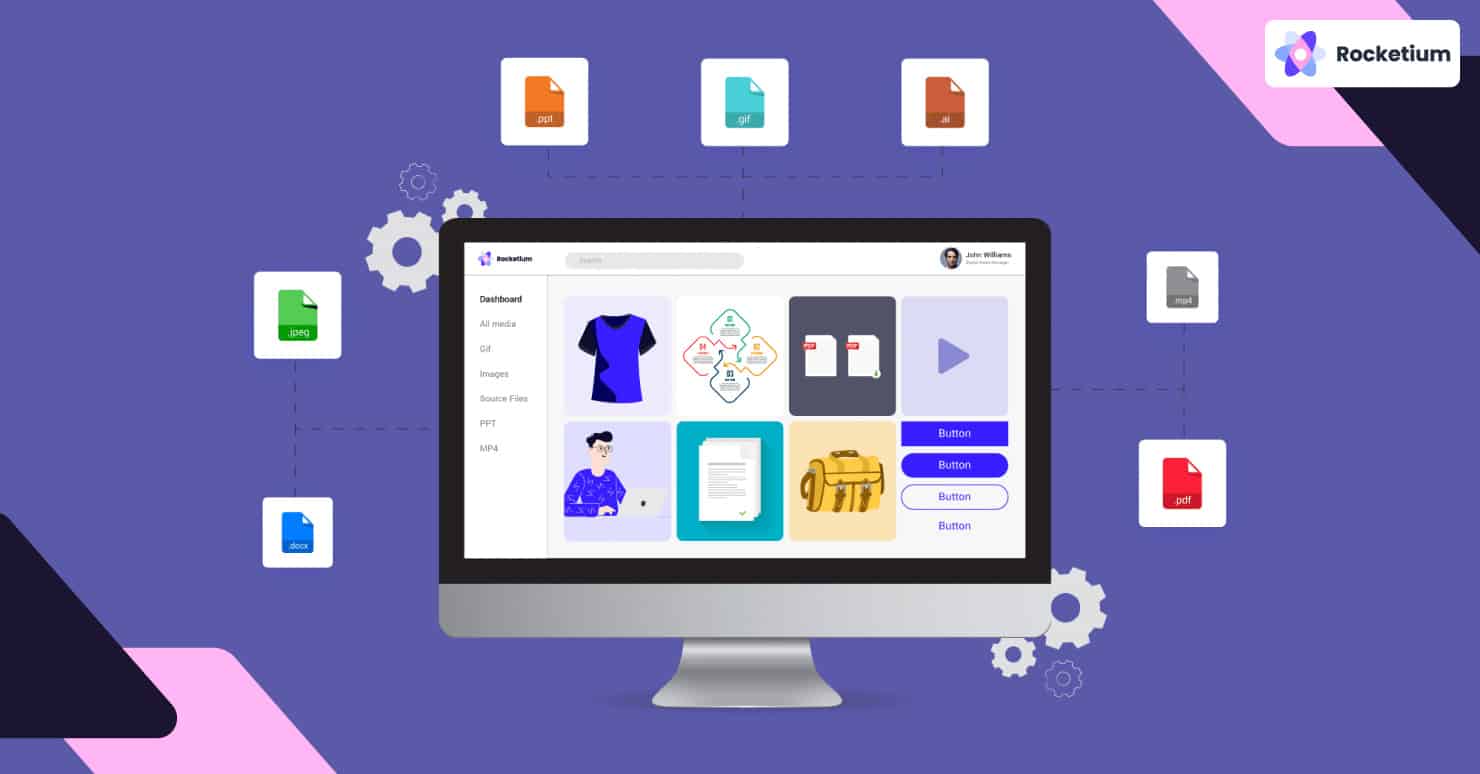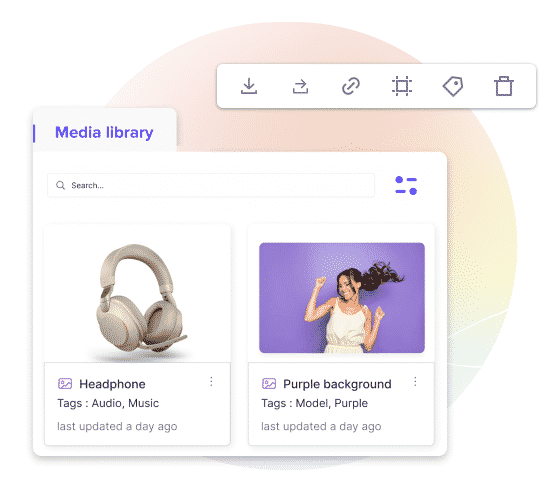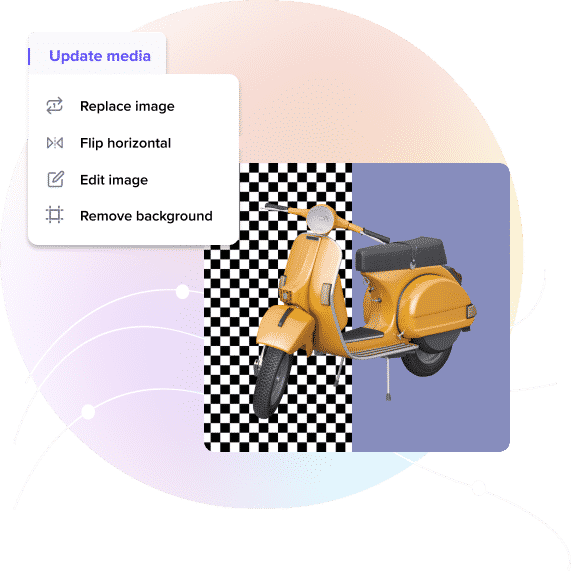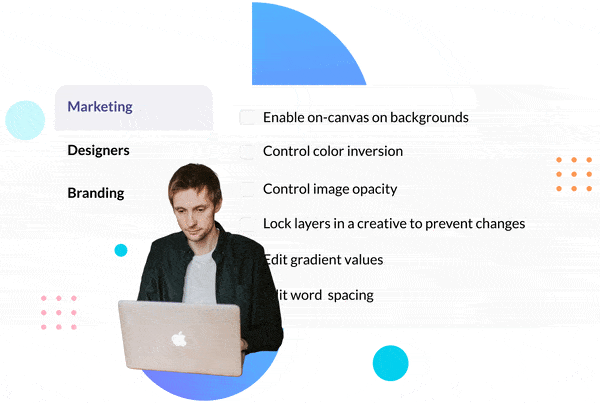Smart DAM for Smart Teams
Store, discover, and re-use campaign assets across the organization to go live faster.
Book a Demo
Store, discover, and re-use campaign assets across the organization to go live faster.
Book a Demo
Digital asset management systems are critical for e-commerce and on-demand companies. Whether you are in the fashion, pharma, groceries, food delivery, or ride-sharing space, the best digital asset management tools help you deliver the right message at the right time. This is critical for building brand recall and driving conversions.
It calls for creating variations at regular intervals throughout a campaign. But that’s not all. You also need to manage thousands of media files efficiently so that you can go live with campaigns faster, and ultimately increase ROI. However, studies show that a vast majority of eCommerce brands don’t do a good job of it.
Did you know that 54% of designers and marketers admitted to using Google to find their company’s logo? Most people end up wasting hours searching for files than actually working on them!

While cloud storage platforms have proliferated, the lack of a central digital asset management system is still a significant problem for brands worldwide. If you run an on-demand business, streamlining digital assets is vital to differentiate yourself from the competition and drive growth.
This is precisely what leading unicorns like BigBasket and Swiggy are doing. They have been leveraging Digital Asset Management (DAM) platforms to launch campaigns faster and capitalize on changing customer preferences, price sensitivities, etc.
Want to learn more about DAM? Check out our definitive guide to DAM.
By streamlining their creative workflows, these unicorns have managed to not only lower the average turnaround time for creative production but also control costs.
Obviously, other brands want a piece of the action too. Many of their competitors are now integrating eCommerce digital asset management solutions of their own!
It is no surprise that the global market for DAM solutions is expected to touch $10.2 billion by 2026.

A lost file or folder containing design files can derail an entire campaign at the last minute. A secure and reliable file management system is indispensable for on-demand companies to scale their campaigns. It can boost the overall productivity and efficiency of the marketing and design teams almost overnight.
Here’s how: on-demand companies typically utilize a huge amount of creative assets across product categories, and target audiences.
Accordingly, they need to develop creative variations based on seasonality, brand affinity, location, offers, etc.
Effectively storing and managing these creative assets becomes pivotal to running campaigns and managing their storefront.
Centralized storage of all the creative assets where you can search, find and utilize quickly across campaigns streamlines creative operations and boosts productivity multi-folds.

It boosts brand compliance and makes it easier to track the performance of creatives. For example, digital asset management systems allow eCommerce businesses to project a consistent brand identity and build customer loyalty by sticking to approved logo designs across channels.
Result: Higher conversion, increased customer lifetime value, and lower customer acquisition cost. It wouldn’t be a stretch to call eCommerce digital asset management a disruptive trend in the world of online marketing!
Digital Asset Management (DAM) tools come in all shapes and sizes. The solution you choose must have certain fundamental features to make your investment worthwhile.
For example, eCommerce digital asset management tools must have advanced image search functionality and customization options.
Here are some tips to help you make an informed decision.

Easy accessibility is one of the top challenges creative teams face regardless of their size or physical location.
The ideal DAM tool should enable users to tag and categorize approved assets by campaign, format, file size, date, or other particulars. This can make it easy for users to instantly filter, sort, and find creative files.
The latest DAM tools even allow you to directly select files from a built-in media library or import them from external sources like spreadsheets and then plug them into banners or videos, using nothing more than their respective tags. Of course, you can customize the library based on the needs of your own workflow.
For example, Big Basket tags its product images with their respective SKU codes. When required, they plug the codes onto a spreadsheet to create or refresh banners in bulk within minutes via an eCommerce digital asset management system. Try to visualize how many more campaigns you’d be able to run with a tool like that!
From social media to remarketing campaigns, video is key in eCommerce marketing. According to Hubspot, 73% of customers who watch product videos go on to make a purchase.
Check whether the DAM tool you are considering allows you to preview video files without importing them or trim them to just the clips you need. The ideal platform should also let you generate videos using tags from external sources.
DAM tools must be scalable and adaptable to the processes and procedures your team follows. The user interface should also be easy to customize according to individual preferences.
This means editable fields, options for configuring workflows, adding comments to files, etc. Ensure that the software you choose allows you to change the navigation and layout as required.

For eCommerce brands, refreshing background from product images is a critical necessity. After all, this allows product images to be reused across campaigns while allowing consistent visual quality.
As any designer will tell you, changing backgrounds manually on software such as Adobe can take hours, impacting turnaround time.
The latest DAM tools allow you to remove backgrounds automatically, enabling you to repurpose the images across different product categories or campaigns with ease.
This is precisely what Ajio has been doing. The company has been leveraging an eCommerce digital asset management software to remove and replace image backgrounds at scale with the click of a button.
Result: They were able to ensure a better match for their banners and save hours on every campaign.
Finding the right images or music to add to a banner/video can take up a lot of time. The best Digital Asset Management tools make content creation easier via integrations with leading stock content platforms like Shutterstock.
The tools allow you to search, add and even edit a variety of design elements in just a few clicks. As a result, scaling content is now easier than ever.

DAM tools should be able to integrate with your favorite storage platforms like Dropbox, Drive, Box, and others with ease. This can be a key feature for large teams working on multiple campaigns.
In fact, brands like Urban Company have set up a direct integration, allowing their teams to save files to a storage platform with a single click.
However, it is important to remember that many DAM tools are an integral part of larger creative management platforms that allow teams to seamlessly develop, produce, store and share creatives, all in a single location.
It makes sense for on-demand companies to explore the full potential of a CMP in terms of design, project management, etc., in addition to digital asset management.
Spreadsheets are clearly not the best bet when it comes to tracking creative iterations/versions for obvious reasons.
If you have an on-site DAM solution, you’re probably better off but the cost of maintenance and upgrades to keep up with business growth can be high.
That is why many brands are switching to cloud-based DAM. It is not only cost-effective (subscription-based) but also allows businesses to scale campaigns with ease.
For example, a cloud-based eCommerce digital asset management system can allow merchants selling on your website to download creatives in different sizes and resolutions with ease – without any intervention from you!

Security is a top priority when you store all your creatives in a common location. A good DAM solution is one that allows you to configure user permissions based on job roles.
It should allow you to specify what assets or features can be accessed by whom and assign users to specific workspaces based on the projects they are working on.
Finally, it should also allow your team to comment, tag co-workers, and track progress on action items.
Knowing how your creative assets are being used is just as important as creating them. It can help you optimize your content strategy and prioritize the best-performing assets.
The ideal DAM system should generate usage reports to help you customize and re-use campaigns and prevent their misuse by tracking downloads.
Creative assets are a type of intellectual property as they often have valuable metadata associated with them. When you collaborate with external agencies, freelancers, or even clients, you could be vulnerable to potential leaks of confidential business data. Implementing DAM is a great way to secure your intellectual property.
The latest DAM tools come with robust security features like role-based access that can help you protect valuable data.
However, they may not be enabled by default. Therefore, it is important that you activate the recommended security features, inventory your assets, and monitor file sharing across departments.
From ride-hailing to groceries and food delivery to healthcare, on-demand companies need a strategic approach to digital asset management. It can help them play to their strengths in an increasingly competitive market.
Rocketium’s proven DAM solution is ideal for growth-conscious brands to better utilize their creative assets and increase ROI over time. As a key part of Rocketium’s proven Creative Management Platform (CMP), it offers a secure, scalable, and feature-rich solution for managing your digital assets.
Rocketium is a leading creative management platform that enables businesses to design and deliver innovative creative campaigns by leveraging the power of AI and automation.
Our suite of creative automation solutions helps you overcome the constraints of time, volume and cost and tell compelling brand stories in a consistent manner. Book a demo today!